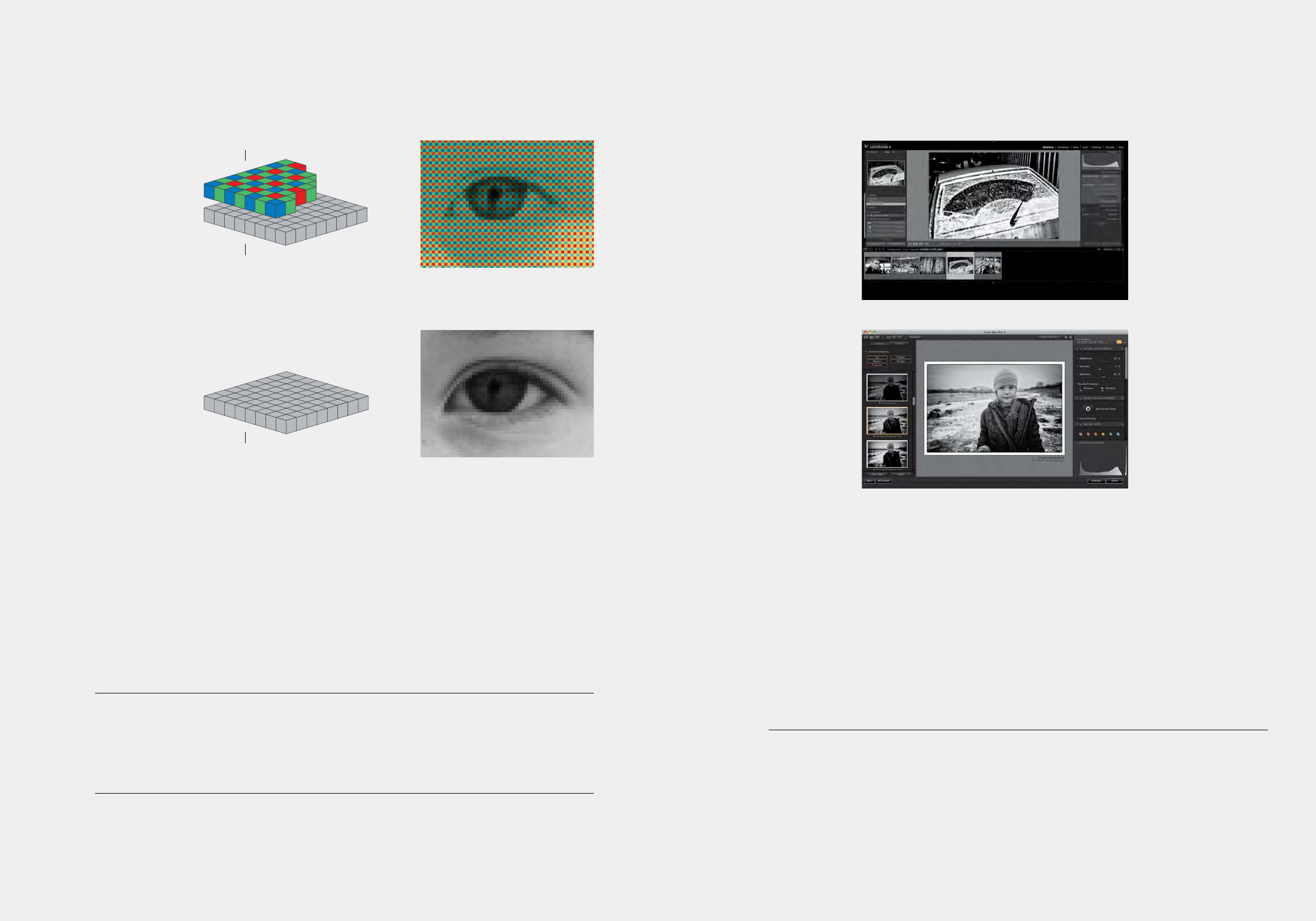
20 I LEICA M MONOCHROM
LEICA M MONOCHROM
Technical details.
COLOUR AND MONOCHROME SENSORS – A COMPARISON
BLACK-AND-WHITE WORKFLOW
Leica M Monochrom customers can
take advantage of a free download of
the digital work flow solution Adobe
®
Photoshop
®
Lightroom
®
4.
M Monochrom customers are also
entitled to a free download of the
Nik Software Silver Efex Pro™
software package.
* As Adobe
®
Photoshop
®
Lightroom
®
4 no longer supports Windows
®
XP, Adobe
®
Photoshop
®
Lightroom
®
3.6 is also available as a free down-
load for XP users.
With a full native resolution of 18 megapixels, the Leica M Monochrom delivers 100 % sharper images than
a colour sensor. As its sensor does not ‘see’ colours, every single pixel records true luminance values.
This means that the M Monochrom delivers a ‘true’ black-and-white image straight from the sensor. The
combination of the brilliant imaging qualities of Leica lenses and perfect harmonisation of the sensor with
the M-System results in images with outstanding sharpness and natural brilliance, without the need for
sharpening in post-processing software. The result is an incomparable image quality that would normally
be expected only from a medium-format camera.
The impressive quality of the native raw data from the M Monochrom not only enables images to be used
directly, but also allows them to be stored in JPEG format with identical resolution. Thanks to the choice
of a low compression rate, the quality of the JPEG files is even comparable with that of professionally
processed TIFF files.
The Leica M Monochrom more than satisfies the expectations of discerning users and fine-art photog-
raphers, with a raw data histogram for the precise assessment of tonal values. The difference compared to
conventional histograms is that it displays original, unprocessed and unmodified raw data. The combin-
ation of this, with a configurable clipping display in particular, allows precise correction or optimisation
of exposures. The subdivision of the raw data histogram into stops enables dedicated black-and-white
photographers to employ a digital interpretation of the zone system.
With the Leica M Monochrom, photographers can apply characteristic toning effects from analogue black-
and-white photography, such as sepia, cold or selenium toning to their images, at the touch of a button.
The user saves the image in JPEG format and selects the desired toning effect – simply and conveniently,
and without the need for post-processing.
MONOCHROME
SENSOR
RAW DATA
HISTOGRAM
(not illustrated)
LENSES WITH
SIX-BIT CODING
(not illustrated)
BLACK-AND-WHITE
WORKFLOW
USEFUL EFFECTS
(not illustrated)
Adobe
®
Photoshop
®
Lightroom
®
4 is a professional workflow solution for Apple Mac
®
OS X, Microsoft
Windows
®
Vista and Microsoft Windows 7*. The software is available as an online download for all new
Leica M Monochrom customers, after online camera registration. It offers a wide range of functions for
the management, processing and exporting of digital images. The latest release now enables the creation
of simple print layouts, slide shows and photo books. In addition, many of its functions, including its
processing speed, have been improved. If the images from the M Monochrom are saved as raw data in the
standardised and future-proof Adobe
®
Digital Negative Format (DNG), Adobe
®
Photoshop
®
Lightroom
®
4,
with its sophisticated and precise processing options, guarantees direct and extremely high-quality image
processing with maximum image quality.
In addition to this, the package also includes a plug-in version of the Nik Silver Efex Pro™ software, con-
sidered to be the most powerful tool for the creation of high-quality digital black-and-white images. For
pictures that perfectly recreate the look of analogue exposures, Silver Efex Pro™ offers selective control of
tonal values and contrast and an extensive collection of profiles for the simulation of black-and-white film
types, grain structures and much more.
The high-performance image sensor of the M Monochrom demands a particularly high spatial resolution
that is, above all, offered by the latest M-Lenses. The excellent correction of optical aberrations and high
resolution makes them all the more suitable for digital use. The current M-Lenses are supplied with a six-bit
code on the bayonet mount that is scanned optically by the M Monochrom as soon as the lens is mounted.
If required, the M Monochrom can compensate for extremely minor, system-inherent vignetting effects on
the basis of this coded information. In addition, the lens type is recorded in the Exif data of the image files
and, when using the latest flash units such as the Leica SF 58, automatically adjusts the reflector to match
the focal length of the lens attached. In most cases, Leica Customer Care can, on request, retrofit six-bit
coding to the mounts of existing M-Lenses.
To allow an image sensor to ‘see in colour’, colour filters in the basic colours – red, green and blue – are allocated to individual pixels. How-
ever, before a visible image can be created, the colour information recorded by neighbouring pixels must be combined – an additive process
that naturally reduces the native sharpness.
The sensor of the Leica M Monochrom does not see colours. As a result, each individual pixel records true luminance values from which a
truly monochrome image, characterised by a native and incomparable sharpness, can be created without any additional processing.
Colour filter
Sensor pixel
Sensor pixel


















